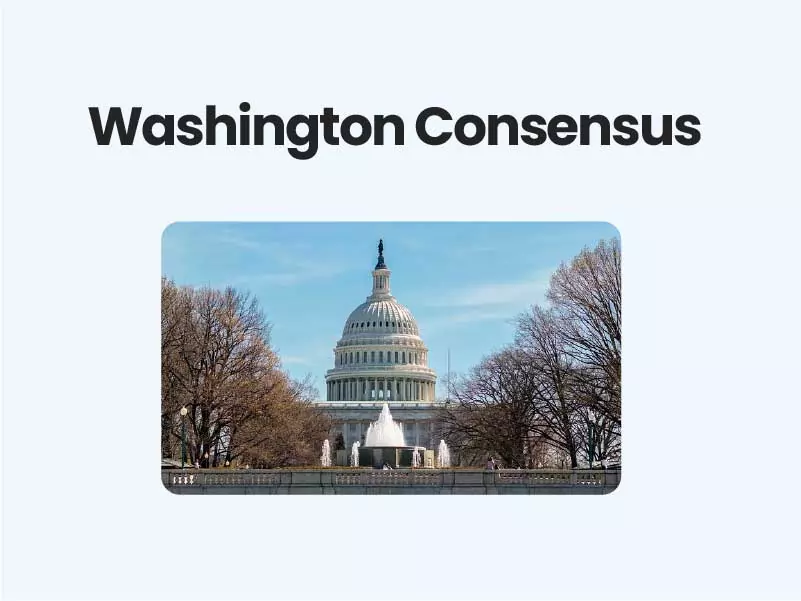
Washington Consensus
The Washington Consensus refers to a set of free-market economic policies supported by prominent financial institutions such as the International Monetary Fund, the World Bank, and the U.S Treasury.
- A British economist named John Williamson coined the term Washington Consensus in 1989.
- The ideas were intended to help developing countries that faced economic crises.
- The Washington Consensus recommended structural reforms that increased the role of market forces in exchange for immediate financial help. Some examples include free-floating exchange ratesand free trade.
- Critics have pointed out that the policies were unhelpful and imposed harsh conditions on the developing countries, others have defended the long-term positive impact of these ideas.

Principles of The Washington Consensus:
These are the ten specific principles originally set out by John Williamson in 1989:
- Low government borrowing. The idea was to discourage developing economies from having high fiscal deficits relative to their GDP.
- Diversion of public spending from subsidies to important long-term growth supporting sectors like primary education, primary healthcare, and infrastructure.
- Implementing tax reform policies to broaden the tax base and adopt moderate marginal tax rates.
- Selecting interest rates that are determined by the market. These interest rates should be positive after taking inflation into account (real interest rate).
- Encouraging competitive exchange rates through freely-floating currency exchange.
- Adoption of free trade policies. This would result in the liberalization of imports, removing trade barrierssuch as tariffs and quotas.
- Relaxing rules on foreign direct investment.
- The privatization of state enterprises. Typically, in developing countries, these industries include railway, oil, and gas.
- The eradication of regulations and policies that restrict competition or add unnecessary barriers to entry.
- Development of property rights.
Read UPSC 2021 Mains Complete Questions
Criticisms :
- Some economists argue that free trade is not always in the best interest of developing economies. Some strategic and infant industries have to be protected initially to provide long-term growth. These industries may also require protection in the form of subsidies or tariffs against imports.
- Chinese firms, aided by the government, have been investing large sums in developing economies in Africa, Asia, and Latin America. These firms typically invest in infrastructure, creating opportunities for long-term trade and growth.
- Privatization can increase productivity and enhance the quality of the product or service. However, privatization can often lead to companies ignoring certain low-income markets or the social needs of a developing economy.
- The free market has its own faults and instabilities. As we saw with the Great Recession in 2008-2009, increased deregulation can lead to financial volatility that can infect the entire economy.

